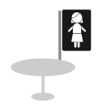Designing Exhibits to Engage Girls
This is a Knowledge Base article, designed to streamline access to and share evidence about informal STEM learning. Knowledge Base articles are evidence-supported claims about what is new and emerging in the field that you can reference when you develop a proposal or "make the case" for a strategy or approach to funders and stakeholders.
Veronica Garcia-Luis co-authored this article.
Research shows that science centers and museums play an important role in giving youth STEM learning opportunities (Hamilton, Nussbaum, Kupermintz, Kerkhoven, & Snow, 1995; Salmi, 2001, 2002). These informal learning spaces use interactive exhibits and programming to spur excitement, generate interest in the sciences, shape STEM identities, and support science skills (National Research Council, 2009). A previous Knowledge Base article on engaging diverse youth further details the potential of informal learning to activate STEM interest.
However, despite these encouraging findings, informal learning spaces don’t always reach girls as readily as they do boys. Studies have found that girls do not visit science museums as often as boys (Borun, 1999; Hamilton et al., 1995; National Science Foundation, 2003). At museums, some exhibits are less attractive to girls than to boys, or engage them for less time (Crowley, Callanan, Tenenbaum, & Allen, 2001; Diamond, 1994; Hill, Corbett, & St. Rose, 2010; Kremer & Mullins, 1992; Lee & Burkam, 1996; National Science Foundation, 2003; Verheyden, 2003).
Informal science education (ISE) practitioners can use evidence to better understand and meet girls’ STEM needs.
Findings from research and evaluation
ISE researchers and practitioners are investigating ways to better engage girls in STEM (Achiam & Holmegaard, 2015; Brown, Huerta Migus, & Williams, 2012; Cardella, Svarovsky, & Dorie, 2013; Laursen, 2011; Munley & Rossiter, 2013; Roughneen, 2011). Increasingly, informal learning institutions are specifically designing programs for girls and women, as well as developing exhibitions that focus on women in STEM and highlight the inequities they face (Cacace, Colonnello, & Olmi, 2011; Laursen, 2011; National Science Foundation, 2003, 2007; Verheyden, 2003). Initial efforts to design exhibits with girls in mind included:
- Studying designs to better engage girls within a singular STEM topic, such as engineering (Cardella et al., 2013; Sinkey, Rosino, & Francisco, 2014; Tranby, Svarovsky, & Cardella, 2014)
- Studying the impacts of a particular design attribute, or design changes to a single interactive exhibit, on girls’ engagement (Crowley et al., 2001; Dancu, 2010)
- Compiling best practices for engaging girls in informal STEM activities (Munley & Rossiter, 2013; National Science Foundation, 2003, 2007).
Looking beyond exhibits, culturally responsive pedagogy (CRP) can identify promising female-responsive strategies. CRP seeks cultural historical patterns of learning for non-dominant groups and integrates those ways of learning into educational designs that are more meaningful and effective (Gay, 2002, 2010; Ladson-Billings, 1995; Paris, 2012). Museums can be more inclusive of females by incorporating exhibits that resonate with females’ patterns of engaging in STEM.
We synthesized prior research about females’ social, historical, and cultural relationships to STEM learning to develop a framework for design (see Dancstep & Sindorf, 2018a). Pulling from theory and practice across varied disciplines, the Female-Responsive Design (FRD) framework identified four strategies that support females in STEM:
- Enable social interaction and collaboration. As suggested in a previous Knowledge Base article on girls and ISE experiences, girls benefit from collaboration with peers during STEM experiences. Cooperative and social STEM experiences lead to greater engagement and better academic performance for females (Peterson & Fennema, 1985; Rosser, 1991; Taylor, 2005). Museums have found that female visitors often prefer working together and supporting each other at exhibits (Diamond, 1994; National Science Foundation, 2003; Taylor, 2005).
- Create a low-pressure setting. Substantial evidence suggests that females may underestimate or lack confidence in their own STEM abilities, and they may avoid activities that seem intimidating or challenging out of fear of looking inadequate (Britner, 2008; Chatman et al., 2008; Hill et al., 2010; Nix, Perez-Felkner, & Thomas, 2015). Therefore, it is important to create comfortable, accessible, safe, open-ended, and playful STEM experiences and settings (Baker, 2013; Gontan, 2013; Sammet & Kekelis, 2016; Vossoughi, Escudé, Kong, & Hooper, 2013).
- Provide meaningful connections. A previous Knowledge Base article on culturally relevant ISE experiences asserted that females have historically preferred STEM content that is meaningful and grounded in context. For example, females showed greater interest in learning math and science when the content was situated in practical applications that improved the lives of people and animals, investigated environmental issues, or addressed societal problems (Froschl, Sprung, Archer, & Fancsali, 2003; Milgram, 2005; Rosser, 1991). In addition, girls’ geometric skills improved when content was presented using a storyline (Casey, Erkut, Ceder, & Mercer Young, 2008).
- Represent females and their interests. Research supports the idea that STEM learning opportunities should reflect diverse science identities and representations (Dawson et al., 2018; Munley & Rossiter, 2013; National Research Council, 2009; Sinkey et al., 2014). Evidence suggests that females engaged more easily with STEM when visuals, topics, and aesthetics related to them (Resnick, Berg, & Eisenberg, 2000; Volman & van Eck, 2001), using their own interests, language, imagery, and aesthetics. These interpretive cues can provide bridges to STEM access.
The research synthesized above catalyzed the field to meet girls’ needs in STEM. We led a project called the Exhibit Designs for Girls’ Engagement (EDGE) that took the next step by exploring at a large scale the impact of a wide range of design attributes on girls’ STEM exhibit experiences.
Exhibit design attributes from the EDGE project
The FRD framework identified 55 exhibit design attributes (plus variations) that might achieve the four strategies detailed above and that had potential to engage girls (Dancstep & Sindorf, 2018a). To narrow down this list, we conducted a large-scale quantitative study that tracked and timed over 900 randomly selected 8–13-year-olds at more than 300 physics, engineering, math, and perception exhibits at three U.S. science centers. The study considered four measures of engagement: exhibit use, time spent, return visits, and high engagement behavior.
Through a series of correlational and regression analyses, we identified nine attributes that were consistently, positively related to girls’ engagement (Dancstep & Sindorf, 2016, 2018b). Girls were more engaged when any of these attributes were present and less engaged when they were missing. Notably, none of these attributes reduced boys’ engagement.
The Nine EDGE Design Attributes
Excerpted from Dancstep & Sindorf, 2018b, and available in a practitioner-friendly format here.
 |
The exhibit’s look and feel is playful, whimsical, or humorous. |
 |
The exhibit’s look and feel is homey, personal, homemade, or delicate. |
 |
The exhibit has multiple stations or sides, allowing more than one person to experience the phenomenon. |
 |
The exhibit is open-ended, providing multiple outcomes, activities, or ways to interact. |
 |
The exhibit has been designed with space to accommodate three or more people. |
 |
The exhibit label includes at least one image of a person. |
 |
The exhibit is designed so visitors can watch others to preview what to do. |
 |
The exhibit label includes a use drawing. |
 |
The exhibit includes at least one familiar object. |
Focus group responses to the design attributes
To learn about girls’ varied experiences with the EDGE Design Attributes, we conducted a follow-up qualitative study (detailed in full in Garcia-Luis & Dancstep, 2019). A total of 22 girls ages 8–13 participated in four focus groups. Participants were video and audio recorded during group discussions and while using four exhibits. Two of the exhibits incorporated all nine attributes between them, while two exhibits did not include any of the design attributes.
Focus group girls engaged repeatedly and spent more time at exhibits that featured the attributes. Of the types of learning evidenced across the focus groups, skill building (repeating and varying activities at exhibits) was much more common at the exhibits that incorporated the EDGE Design Attributes. Focus group girls expressed largely positive responses to the EDGE Design Attributes. Still, several girls voiced surprise that two of the attributes worked to engage girls at exhibits (in the large-scale study), Image of a person and Multiple stations or sides. This variation reinforces the CRP notion that educational approaches should not be prescriptive; that is, not all attributes will work for all girls.
Advancing the field
Researchers have pointed ot the need for science centers and museums to address inequities within their walls (Dawson, 2019; Feinstein, 2017; Fischer, Anila, & Moore, 2017). As they work to create more inclusive spaces, museum leaders and exhibit designers might consider incorporating the EDGE Design Attributes. Although not every attribute will apply to every exhibit, their general application across institutions, exhibits, and time will help us create more female-responsive places of learning.
As researchers have also pointed to the importance of intersectional analysis, future studies might examine how the FRD framework and EDGE Design Attributes intersect with gender, culture, age, and STEM identities (Gay, 2002, 2010; Modi, Schoenberg, & Salmond, 2012; Paris, 2012; West & Fenstermaker, 1995). Future studies might also investigate how the EDGE Design Attributes directly impact girls’ learning and engagement. Finally, investigating designs that are not currently in the exhibit design toolkit and were therefore not incorporated in the studies described above can push beyond the status quo and greatly advance the field.
This material is based upon work supported by the National Science Foundation (NSF) under grant no. 1323806. Any opinions, findings, and conclusions or recommendations expressed in this material are those of the authors and do not necessarily reflect the views of NSF.
Photo courtesy of Amy Snyder, © Exploratorium.
References
Achiam, M., & Holmegaard, H. T. (2015). Hypatia Project: Criteria for Gender Inclusion.
Baker, D. (2013). What works: Using curriculum and pedagogy to increase girls' interest and participation in science. Theory Into Practice, 52(1), 14–20. doi:10.1080/07351690.2013.743760
Borun, M. (1999). Gender roles in science museum learning. Visitor Studies Today!, 3(3), 11–14.
Britner, S. L. (2008). Motivation in high school science students: A comparison of gender differences in life, physical, and earth science classes. Journal of Research in Science Teaching, 45(8), 955–970. doi:10.1002/tea.20249
Brown, J., Huerta Migus, L., & Williams, M. (2012). Girls RISE (Raising Interest in Science and Engineering) Museum Network. National Science Foundation GSE/EXT Award Number 0937245.
Cacace, M., Colonnello, C., & Olmi, A. (2011). TWIST: Guidelines for Communication Activities on Women in Science to be Implemented by Science Centres and Museums. Retrieved from www.the-twist-project.eu/media/dyn/TWIST.GuidelinesReport.pdf
Cardella, M. E., Svarovsky, G. N., & Dorie, B. L. (2013). Gender Research on Adult-Child Discussions within Informal Engineering Environments (GRADIENT): Early Findings. American Society for Engineering Education.
Casey, M. B., Erkut, S., Ceder, I., & Mercer Young, J. (2008). Use of a storytelling context to improve girls' and boys' geometry skills in kindergarten. Journal of Applied Developmental Psychology, 29, 29–48.
Chatman, L., Nielsen, K., Strauss, E. J., Tanner, K. D., Atkin, J. M., Bequette, M. B., & Phillips, M. (2008). Girls in Science: A Framework for Action. Arlington, VA: NSTA Press.
Crowley, K., Callanan, M., Tenenbaum, H., & Allen, E. (2001). Parents explain more often to boys than to girls during shared scientific thinking. Psychological Science, 12(3), 258–261.
Dancstep, T., & Sindorf, L. (2016). Exhibit Designs for Girls’ Engagement: A Guide to the EDGE Design Attributes. Retrieved from www.exploratorium.edu/sites/default/files/pdfs/EDGE_GuideToDesignAttributes_v16.pdf
Dancstep, T., & Sindorf, L. (2018a). Creating a Female-Responsive Design Framework for STEM exhibits. Curator, 61(3), 469–484.
Dancstep, T., & Sindorf, L. (2018b). Exhibit Designs for Girls' Engagement (EDGE). Curator, 61(3), 485–506.
Dancu, T. (2010). Designing Exhibits for Gender Equity. (Doctor of Philoshophy), Portland State University. Retrieved January 30, 2012, from Dissertations & Theses: Full Text. (Publication No. AAT 3439173), Portland, Oregon.
Dawson, E. (2019). Equity, Exclusion and Everyday Science Learning. London and New York: Routledge.
Dawson, E., Archer, L., Seakins, A., Godec, S., DeWitt, J., King, H., Mau, A., & Nomikou, E. (2018). Selfies at the science museum: Exploring girls’ identity performances in a science learning space. Gender and Education. doi: 10.1080/09540253.2018.1557322
Diamond, J. (1994). Sex differences in science museums: A review. Curator, 37(1), 17–24.
Feinstein, N. W. (2017). Equity and the meaning of science learning: A defining challenge for science museums. Science Education, 101, 533–538.
Fischer, D., Anila, S., & Moore, P. (2017). Coming together to address systemic racism in museums. Curator, 60(1), 23–31.
Froschl, M., Sprung, B., Archer, E., & Fancsali, C. (2003). Science, Gender, and Afterschool: A Research-Action Agenda. Retrieved from www.fhi360.org/resource/science-gender-and-afterschool-research-action-agenda
Garcia-Luis, V., & Dancstep, T. (2019). Straight from the girls: Why you should incorporate the EDGE Design Attributes at exhibits. Curator, 62(2) 195–221.
Gay, G. (2002). Preparing for culturally responsive teaching. Journal of Teacher Education, 53(2), 106–116.
Gay, G. (2010). Culturally Responsive Teaching: Theory, Research, and Practice (2nd ed.). New York, NY: Teachers College Press.
Gontan, I. (2013). Full Spectrum Science: Successful Strategies in Engaging Latina Girls in STEM Programming. (Master of Arts in Museum Studies), John F. Kennedy University, San Francisco, CA.
Hamilton, L. S., Nussbaum, E. M., Kupermintz, H., Kerkhoven, J. I. M., & Snow, R. (1995). Enhancing the validity and usefulness of large-scale educational assessments: II. NELS: 88 science achievement. American Educational Research Journal, 32(3), 555–581.
Hill, C., Corbett, C., & St. Rose, A. (2010). Why so few? Women in science, technology, engineering, and mathematics. AAUW, Washington DC. Retrieved from www.aauw.org/research/why-so-few
Kremer, K., & Mullins, G. (1992). Children’s gender behavior at science museum exhibits. Curator, 35(1), 39–48.
Ladson-Billings, G. (1995). Toward a theory of culturally relevant pedagogy. American Educational Research Journal, 32(3), 465–491.
Laursen, S. (2011). Program for Gender Day.
Lee, V. E., & Burkam, D. T. (1996). Gender differences in middle grade science achievement: Subject domain, ability level, and course emphasis. Science Education, 80(6), 613–650.
Milgram, D. (2005). Gender Differences in Learning Style Specific to Science, Technology, Engineering and Math. Retrieved from www.iwitts.org/proven-practices/retention-sub-topics/learning-style/297-gender-difference-in-learning-style-specific-to-science-technology-engineering-and-math-stem
Modi, K., Schoenberg, J., & Salmond, K. (2012). Generation STEM: What Girls Say about Science, Technology, Engineering, and Math. Girl Scout Research Institute.
Munley, M. E., & Rossiter, C. (2013). Girls, Equity, and STEM in Informal Learning Settings: A Review of Literature. Retrieved February 17, 2014.
National Research Council. (2009). Learning Science in Informal Environments: People, Places, and Pursuits. Washington, DC: National Academies Press.
National Science Foundation. (2003). New Formulas for America's Workforce: Girls in Science and Engineering. Arlington, VA: NSF 03-207.
National Science Foundation. (2007). New Formulas for America's Workforce 2: Girls in Science and Engineering. Arlington, VA: National Science Foundation.
Nix, S., Perez-Felkner, L., & Thomas, K. (2015). Perceived mathematical ability under challenge: A longitudinal perspective on sex segregation among STEM degree fields. Frontiers in Psychology, 6.
Paris, D. (2012). Culturally sustaining pedagogy: A needed change in stance, terminology, and practice. Educational Researcher, 41(3), 93–97.
Peterson, P., & Fennema, E. (1985). Effective teaching, student engagement in classroom activities, and sex-related differences in learning mathematics. American Educational Research Journal, 22(3), 309–335.
Resnick, M., Berg, R., & Eisenberg, M. (2000). Beyond black boxes: Bringing transparency and aesthetics back to scientific investigation. Journal of the Learning Sciences, 9(1), 7–30.
Rosser, S. V. (1991). Female Friendly Science: Applying Women’s Studies Methods and Theories to Attract Students. New York: Teachers College Press.
Roughneen, C. (2011). The Gender Issue. Ecsite Newsletter. Retrieved from www.the-twist-project.eu/media/dyn/document/Ecsite_88_The_Gender_Issue.pdf
Salmi, H. (2001). Public understanding of science: Universities and science centres. Paper presented at the Management of University Museums; Education and Skills; OECD, Paris.
Salmi, H. (2002). Factors Affecting Students' Choice of Academic Studies: The Motivation Created by Informal Learning. Retrieved October 10, 2008, from The Finnish Science Center.
Sammet, K., & Kekelis, L. (2016). Changing the Game for Girls in STEM: Findings on High Impact Programs and System-building Strategies.
Sinkey, A., Rosino, L., & Francisco, M. (2014). Designing Our World: Public Audiences Front-End Evaluation Report. Oregon Museum of Science & Industry, Portland, OR.
Taylor, D. (2005). Social science: Observing women and girls in the museum. ASTC Dimensions, May/June, 11–12.
Tranby, Z., Svarovsky, G., & Cardella, M. (2014). GRADIENT: Gender Research on Adult-Child Discussions in Informal Engineering Environments. In: National Science Foundation award 1136253.
Verheyden, P. (2003). The great sexperiment. ECSITE Newsletter, 54(Spring), 10–11.
Volman, M., & van Eck, E. (2001). Gender equity and information technology in education: The second decade. Review of Educational Research, 71(4), 613–634.
Vossoughi, S., Escudé, M., Kong, F., & Hooper, P. (2013). Tinkering, Learning & Equity in the After-School Setting. Paper published as a part of FabLearn Conference Proceedings, Stanford University, Palo Alto, CA.
West, C., & Fenstermaker, S. (1995). Doing difference. Gender and Society, 9(1), 8–37.